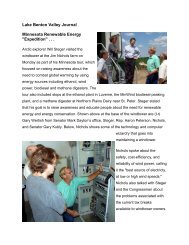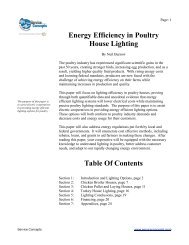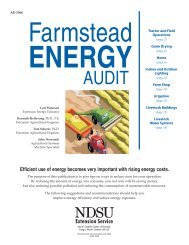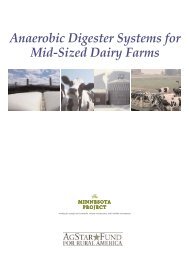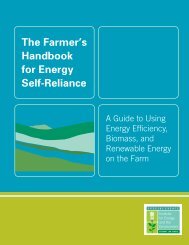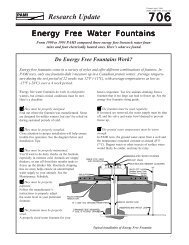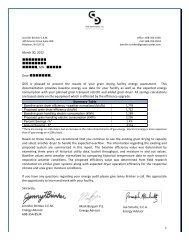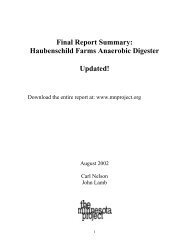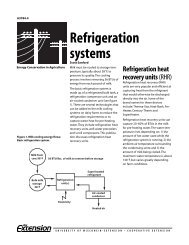Dairy Farm Energy Management Handbook - Wisconsin Department ...
Dairy Farm Energy Management Handbook - Wisconsin Department ...
Dairy Farm Energy Management Handbook - Wisconsin Department ...
You also want an ePaper? Increase the reach of your titles
YUMPU automatically turns print PDFs into web optimized ePapers that Google loves.
and bears a heavier load to achieve the desired amount of cooling,<br />
which costs more in electricity.<br />
In many cases, you can repair louvers that are sticking (in the open or<br />
closed position) just by cleaning them and applying a dry graphite<br />
lubricant to the hinges. Graphite is recommended over oil because it will<br />
not attract dirt as rapidly and thus reduce the maintenance interval.<br />
Any obstruction on the discharge of a fan impedes airflow. In short, fans<br />
with louvers on the outside are less efficient than comparable fans with<br />
louvers on the inside.<br />
You may have to spend some time shopping to find fans with inside<br />
louvers since most fan louvers are built for installation on the discharge<br />
side.<br />
Louvers also come in two basic types: motor-activated and air-activated.<br />
Air-activated louvers reduce airflow 20% to 30% and are less efficient<br />
because fan power pushes the shutters open.<br />
Motor-activated louvers eliminate that problem because the shutters lift<br />
and close automatically. In addition, motor-activated louvers will work<br />
even when dirty or when the joints get stiff, so cold air is less likely to<br />
enter during wintry days.<br />
• Safety guards should be used on fans within reach of personnel to<br />
prevent accidents. The guard supplied by the manufacturer is usually<br />
best because it lowers fan airflow and efficiency very little (usually by<br />
less than 5%).<br />
• Installing thermostats to control the fans’ on-and-off operation saves<br />
energy and increases productivity.<br />
Research has indicated that dairy cows begin to show heat stress at 74°<br />
F with 70% relative humidity (the average relative humidity for<br />
<strong>Wisconsin</strong>), so it is recommended that the thermostat be set between<br />
70° F and 75° F.<br />
Sanford recommends using a thermostat designed for outdoors in<br />
damp, dusty conditions. He suggests mounting the thermostats out of<br />
the reach of animals but in an area that will accurately reflect air<br />
temperatures around the livestock.




